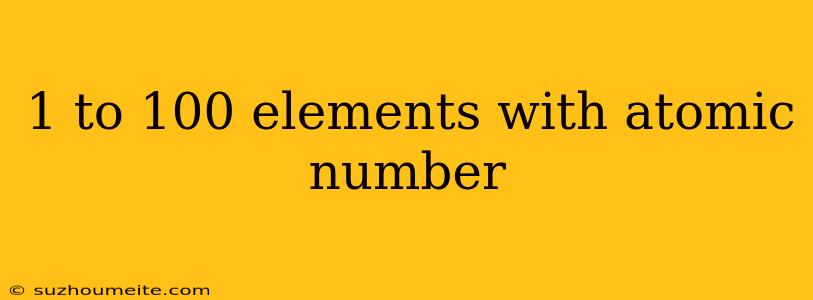The Periodic Table: A Comprehensive Guide to the First 100 Elements
The periodic table is a fundamental tool in chemistry, displaying the known elements in a logical and organized manner. In this article, we will delve into the first 100 elements, exploring their atomic numbers, symbols, and some interesting facts about each element.
1-10: The Lightest Elements
- Hydrogen (H) - Atomic Number 1: The lightest and most abundant element in the universe.
- Helium (He) - Atomic Number 2: A noble gas used in balloons and airships.
- Lithium (Li) - Atomic Number 3: A highly reactive alkali metal used in batteries.
- Beryllium (Be) - Atomic Number 4: A lightweight metal used in aerospace industry.
- Boron (B) - Atomic Number 5: A metalloid used in fiberglass and semiconductors.
- Carbon (C) - Atomic Number 6: The basis of all life on Earth, found in all living organisms.
- Nitrogen (N) - Atomic Number 7: A colorless gas making up 78% of the Earth's atmosphere.
- Oxygen (O) - Atomic Number 8: A highly reactive gas essential for human life.
- Fluorine (F) - Atomic Number 9: A highly reactive gas used in toothpaste and refrigerants.
- Neon (Ne) - Atomic Number 10: A noble gas used in neon signs and plasma TVs.
11-20: The Alkali Metals and Alkaline Earth Metals
- Sodium (Na) - Atomic Number 11: A highly reactive metal used in streetlights and soap.
- Magnesium (Mg) - Atomic Number 12: A key element in plant growth and fireworks.
- Aluminum (Al) - Atomic Number 13: A lightweight metal used in aircraft and cooking foil.
- Silicon (Si) - Atomic Number 14: A metalloid used in computer chips and concrete.
- Phosphorus (P) - Atomic Number 15: An essential element for DNA and ATP production.
- Sulfur (S) - Atomic Number 16: A yellow nonmetal used in matches and volcanic eruptions.
- Chlorine (Cl) - Atomic Number 17: A greenish-yellow gas used in swimming pools and bleach.
- Argon (Ar) - Atomic Number 18: A noble gas used in light bulbs and lasers.
- Potassium (K) - Atomic Number 19: A highly reactive metal used in fertilizers and explosives.
- Calcium (Ca) - Atomic Number 20: A key element in bones and teeth.
21-30: The Transition Metals
- Scandium (Sc) - Atomic Number 21: A lightweight metal used in aluminum alloys.
- Titanium (Ti) - Atomic Number 22: A strong and lightweight metal used in aerospace industry.
- Vanadium (V) - Atomic Number 23: A hard, silver-white metal used in alloys.
- Chromium (Cr) - Atomic Number 24: A shiny metal used in car bumpers and chrome plating.
- Manganese (Mn) - Atomic Number 25: A hard, silver-white metal used in steel production.
- Iron (Fe) - Atomic Number 26: A key element in hemoglobin and steel production.
- Cobalt (Co) - Atomic Number 27: A hard, silver-white metal used in magnets and alloys.
- Nickel (Ni) - Atomic Number 28: A corrosion-resistant metal used in alloys and batteries.
- Copper (Cu) - Atomic Number 29: A highly conductive metal used in electrical wiring and coins.
- Zinc (Zn) - Atomic Number 30: A bluish-white metal used in galvanizing and batteries.
31-40: The Transition Metals (Continued)
- Gallium (Ga) - Atomic Number 31: A soft, silvery metal used in semiconductors and thermometers.
- Germanium (Ge) - Atomic Number 32: A metalloid used in semiconductors and fiber optics.
- Arsenic (As) - Atomic Number 33: A highly toxic metalloid used in insecticides and semiconductors.
- Selenium (Se) - Atomic Number 34: A nonmetal used in photocopiers and solar cells.
- Bromine (Br) - Atomic Number 35: A reddish-brown liquid used in water treatment and pharmaceuticals.
- Krypton (Kr) - Atomic Number 36: A noble gas used in lasers and lighting.
- Strontium (Sr) - Atomic Number 37: A soft, silvery metal
